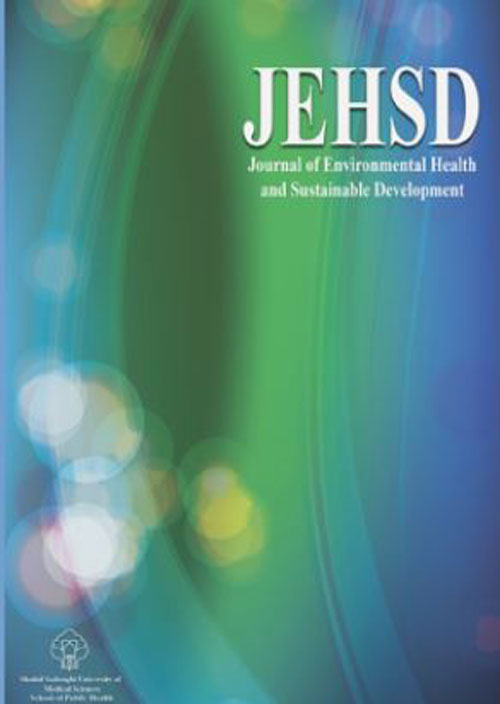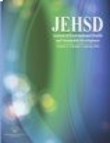فهرست مطالب

Journal of Environmental Health and Sustainable Development
Volume:5 Issue: 3, Sep 2020
- تاریخ انتشار: 1399/08/19
- تعداد عناوین: 8
-
Pages 1033-1034
-
Pages 1035-1042Introduction
High concentration of inhalable airborne particles can increase the risk of lung disease in exposed people. This study aimed to determine the respirable particulate matter (PM5) concentration in traditional bakeries of Saveh in 2020.
Materials and MethodsThis cross-sectional descriptive study was conducted among 25 bakeries where the samples were collected by cyclone and teflon filter equipped by air sampling pump. Later, the respirable particulate matter concentration was measured using gravimetric method. The collected PM5 was scanned using a FTIR (Fourier-transform infrared spectroscopy) with regard to flour dust. In addition, size and shape of the collected PM5 were analyzed using a scanning electron microscope (SEM).
ResultsFindings showed that the Lavash bakery had the highest PM5 concentration (9.15 mg/m3) in comparison with two other bakeries (Sangak and Barbari). However, an inverse relationship was observed between RH and particle concentration. In addition, the results demonstrated that increasing RH decreased the particle concentration, but the relationship was not significant(P = 0.052, Spearmanchr('39')s rho = -0.393). Furthermore, Lavash bakery had the lowest average size of PM5 (0.63 ± 0.32 μm). However, the FTIR scans confirmed that the flour dust had the predominant amount of PM5.
ConclusionBased on the findings, the density of respirable PM5 has a high level in Saveh bakeries and workers are exposed to high levels of PM.
Keywords: Respirable Particulate Matter, Bakery, Indoor Air, Saveh City -
Pages 1043-1052Introduction
Landfill siting is a difficult, complex, and protracted process, which requires evaluating different criteria. A suitable site should be located to dispose the municipal solid wastes hygienically (sanitary landfill), which is one of the fundamental subjects related to the environmental stability of the human settlements. The aim was to select a suitable waste disposal area using fuzzy-Analytic Hierarchy Process (AHP) models.
Materials and MethodsTo conduct this study, the information about elevation, slope, soil, drainage, vegetation, land use, population, and roads were produced and corrected in layers called shape files using the Geographic Information System (GIS) software. Finally, weights were applied in expert choice software by combining and overlapping information layers in GIS.
ResultsBased on the fuzzy-AHP model, 6 sites were identified as suitable areas for municipal waste disposal. Among the selected sites, one site was highly suitable, two were suitable, and three sites were moderately suitable. These areas with an area of 83.8 km2 are located along the west part of the city adjacent to the Iraqi border. The unsuitable sites for municipal waste disposal were located in the eastern and northeastern areas.
ConclusionHowever, applying fuzzy-AHP model provides the necessary conditions for assessing effective relationships among discrete criteria. In the end, combining these models and their findings represented advantages of this kind of modeling and improved scoring in all of these pixels.
Keywords: Landfill, Fuzzy-AHP, Geographic Information System, Ilam City -
Pages 1053-1062Introduction
Applying of a new indicator in food packaging can be effective to inform consumers about the freshness and quality of the products.
Materials and MethodsIn the current study, a new milk freshness label was investigated containing beetroot color and multi layers of polystyrene. The label characteristics were investigated by estimating color number, release test, and scanning electron microscopy (SEM). The total bacterial count, pH, lactic acid concentration in milk, and label color number were measured using standard plate count, pH meter, titration of acidity, color analysis software, and UV spectrophotometry on days 0, 3, 4, 5, 6, and 7 at refrigerator temperature (4 ± 0.2°C).
ResultsThe label reacted to total bacterial count and pH changes with a visible color during milk spoilage. A positive correlation was found between the label color changes, total bacterial count, and pH. The color of label turned from dark red to light brown, which was related to the chemical changes and bacterial count of milk.
ConclusionAccording to this simple, visible, and affordable label, the shelf life of pasteurized milk was estimated as five days.
Keywords: Food Packaging, Milk, Freshness Indicator -
Pages 1063-1076Introduction
Microcystin-leucine arginine (MC-LR) is a toxin with harmful effects on the liver, kidney, heart, and gastrointestinal tract. So, effective removal of MC-LR from water resources is of great importance. The aim of this study was to remove microcystin-LR (MC-LR) from aqueous solution by Titanium Dioxide (TiO2).
Materials and MethodsIn the present study, TiO2, as a semiconductor, was used for photodegradation of MC-LR under ultraviolet light (UV). The Response Surface Methodology was applied to investigate the effects of operating variables such as pH (A), contact time (B), and catalyst dose (B) on the removal of MC-LR. The MC-LR concentration was measured by high-performance liquid chromatography (HPLC).
ResultsThe results showed that single variables such as A, B, and C had significant effects on MC-LR removal (pvalue < 0.05). In other words, increase of the contact time and catalyst dose had a positive effect on enhancing the removal efficiency of MC-LR, but the effect of pH was negative. The analysis of variance showed that BC, A2, and C2 variables had a significant effect on the MC-LR removal (pvalue < 0.05). Finally, the maximum removal efficiency of MC-LR was 95.1%, which occurred at pH = 5, contact time = 30 minutes, and catalyst dose = 1 g/l.
ConclusionAccording to the findings, TiO2, as a photocatalyst, had an appropriate effect on degradation of the MC-LR.
Keywords: Microcystin-LR, TiO2, Photocatalytic Degradation, Response Surface Methodology -
Pages 1077-1090Introduction
the aim of this study was to determine the quantity and quality of indoor and outdoor air fungus bioaerosols in Khorramabad day care child centers.
Materials and MethodsA total of 180 air samples were collected from 10 centers in 2018. The samples included 7 indoor and 2 outdoor sampling points. The total number of children was 580. Sampling of fungal bioaerosols was performed by the ZEFON pump (ZEFON factory, USA) with a flow rate of 28.3 L/min. The Sabouraud Dextrose Agar containing chloramphenicol was used as the culture medium. Relative humidity and temperature were measured by a Hygro-Thermometer (TES-1360A- Taiwan-made Humidity and temperature meter).
ResultsThe results showed that 96.1 % of the samples were positive and had grown colonies. The highest amount of fungal agents in the indoor air and outdoor air were 175.58 CFU/m3 and 274.56 CFU/m3 in May, while the lowest rates were 3.4 CFU/m3 and 7.8 CFU/m3 in July, respectively. Aspergillus niger and Mucor were the most highly abundant fungus genera, while Fusarium was the lowest one. In all samples, the I/O (indoor/outdoor) ratio was more than 1; so, fungal bioaerosols in indoor environments were dominant than the outdoor fungal bioaerosols. The relationship of fungal bioaerosols with RH and T)°C( was significant (P-value = 0.001).
ConclusionGenerally, the amount of contamination is considerable in the studied day care child centers. Therefore, ventilation modification is recommended by a purifier filter. Moreover, the ventilation conditions and favorable air standards should be monitored continuously by supervisory authorities.
Keywords: Fungi, Air Pollution, Indoor, Child Day Care Centers, Iran -
Pages 1091-1102Introduction
One of biological wastewater treatment methods that utilizes to both digesting waste activated sludge and methane production is anaerobic digestion (AD). It is believed to be most effective solution in terms of energy crisis and environmental pollution issues.
Materials and MethodsIn this study the sludge was digested anaerobically sampled from a full-scale WWTP, located at south of Tehran, Iran for evaluation. To study the microbial community within the sludge the MiSeq Sequencing method utilized. Based on our field data and microbial community data, a schematic diagram of probable leading pathways was made in the studied digester.
ResultsAt first, the community variety in the bulk sludge and richness were enhanced followed by loading increasing. Meanwhile, the loading change enhanced the community richness and variety of the sludge. By comparing the rank-abundance distributions, a shallow gradient would show high evenness since the abundances of diverse species are alike. The results showed all the communities were extremely diverse and 15 phyla were distinguished in the sludge sample. The dominant phyla of the community were Bacteroidetes and Firmicutes and quantity of the two phyla were 21% and 11%, respectively. Anaerobaculum, Acinetobacter, Syntrophomonas, and Coprothermobacter were the chief genera for the microbial communities and the sum of four genera were 7%, 3%, 3%, and 2%, respectively.
ConclusionIt was shown that syntrophic acetate oxidizing bacterias (SAOBs) metabolized acetate through hydrogen trophic methanogenesis in the digester. Generally, the findings may be useful to help the wastewater operators to utilize an effective method that able to treat waste sludge plus methane production, simultaneously.
Keywords: Microbial Community, Methane Production Pathway, Biogas, Anaerobic Digester


